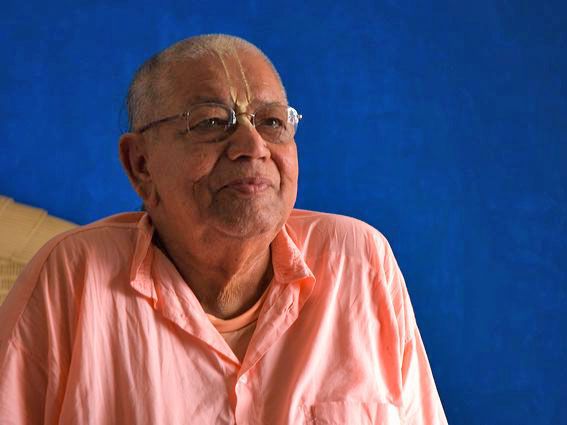How practitioners present themselves for service each day.
By Srila Bhakti Sundar Govinda Dev-Goswami Maharaj
There is a mantra from self-meditation. I think anyone who has received second initiation knows this mantra.
divyam sri-hari-mandiradhya-tilakam kantham sumalanvitam
vaksah sri-hari-nama-varna-subhagam sri-khanda-liptam punah
putam suksma-navambaram vimalatam nityam vahantim tanum
dhyayech chhri-guru-pada-padma-nikate sevotsukan chatmanah
We are meditating on this mantram until we attain the position it describes. When we reach that position, then it is no longer necessary to meditate on the mantram, but until we reach that position, we are meditating on it. This is theory and practice.
Divyam Sri-Hari-mandiradhya-tilakam: my form is decorated with tilak in the twelve places on the body that we conceive of as Temples of the Lord.
lalate kesavam dhyayen narayanam athodare
vaksah-sthale madhavam tu govindam kantha-kupake
visnun cha daksine kuksau bahau cha madhusudanam
trivikramam kandhare tu vamanam vama-parsvake
sridharam vama-bahau tu hrsikesam tu kandhare
prsthe tu padmanabhan cha katyam damodaram nyaset
tat praksalana-toyan tu vasudeveti murdhani
The forehead is Kesava’s Temple. The belly is Narayan’s Temple. The chest is Madhava’s Temple. The throat is Govinda’s Temple. The right side is Visnu’s Temple. And so on in this way. We mark with tilak all these Temples of the Lord; the Lord protects our spiritual mood of devotion. Then we wash our hand and wipe it on our head.
Divyam Sri-Hari-mandiradhya-tilakam: all the Temples in the body appear beautiful with tilak on them. Kantham sumalanvitam: a tulasi-mala always lives on my neck. Tulasi is very dear to Krishna, and Krishna always stays with Tulasi. When I wear a tulasi-mala, Krishna must stay with me. Krishna may not like me, but He likes Tulasi. So, I always wear a tulasi-mala around my neck.
Vaksah Sri-Hari-nama-varna-subhagam sri-khanda-liptam punah: my form as a worshipper is decorated with sandalwood paste, and on my chest is written Names of the Lord like ‘Rama’ and ‘Krishna’, according to my desire. Putam suksma-navambaram: I am wearing the very fine, new, clean cloth.
Vimalatam nityam vahantim tanum: my form is spotless. It is a pure, transcendental, eternal form. My body is not this gross physical body or subtle mental body. Actually, I have a transcendental, conscious body, which is clean and clear. There is nothing bad covering it. It is existing with full consciousness, and it is decorated with tilak, a tulasi-mala, clean clothes, and other auspicious things.
Dhyayech Chhri-Guru-pada-padma-nikate sevotsukan chatmanah: meditating on my form in this way, I pray to my Gurudev, “Please engage me in the service of Krishna. I am present here before you. This is my form, and I can now do some service for Krishna if you give that service to me.”
This is the feeling within this mantra for meditation. Actually, we cannot see, but Krishna can see us. First, this feeling is necessary. We cannot see anything with our mundane eyes, but if our eyes become transcendental, then we can see Krishna. Until then, we are presenting ourselves through this mantra. Before we worship the Lord, we meditate on our body in this way, and it is necessary for us to reach that position. That is called sadhana, practising life.
References
divyam sri-hari-mandiradhya-tilakam kantham sumalanvitam
vaksah sri-hari-nama-varna-subhagam sri-khanda-liptam punah
putam suksma-navambaram vimalatam nityam vahantim tanum
dhyayech chhri-guru-pada-padma-nikate sevotsukan chatmanah
“Meditate that the Lord’s Temple (one’s body) is decorated with shining tilak, one’s neck bears a beautiful tulasi-mala, one’s chest is adorned with the Names of Sri Hari and sandalwood paste, one is wearing fine, new, clean cloth, and in one’s pure, eternal form, one is at the lotus feet of Sri Guru, eager for service.”
lalate kesavam dhyayen narayanam athodare
vaksah-sthale madhavam tu govindam kantha-kupake
visnun cha daksine kuksau bahau cha madhusudanam
trivikramam kandhare tu vamanam vama-parsvake
sridharam vama-bahau tu hrsikesam tu kandhare
prsthe tu padmanabhan cha katyam damodaram nyaset
tat praksalana-toyan tu vasudeveti murdhani
“Meditating on Kesava, mark the forehead, on Narayan the belly, on Madhava the chest, on Govinda the throat, on Visnu the right side, on Madhusudan the right arm, on Trivikram the right shoulder, on Vaman the left side, on Sridhar the left arm, on Hrsikes the left shoulder, on Padmanabha the upper back, and on Damodar the lower back. Meditating on Vasudev, wipe the water used to wash (the hand) on the top of the head.”









